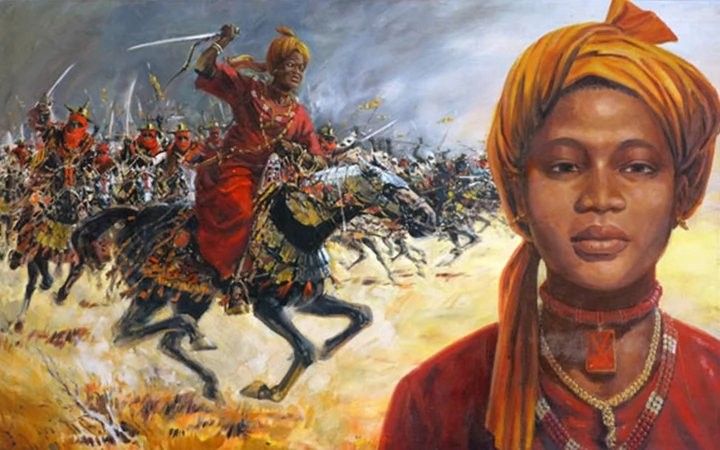The Legendary Queen Amina of Zaria: A Warrior, Leader, and Icon of Strength

The Legendary Queen Amina of Zaria: A Warrior, Leader, and Icon of Strength
Discover the inspiring story of Queen Amina of Zaria, the fearless warrior and visionary leader whose legacy remains a symbol of strength and empowerment in African history.
Queen Amina of Zaria, also known as Queen Aminatu, is one of Africa's most celebrated historical figures. Born in 1533 into the royal family of Zazzau (modern-day Zaria in Kaduna State, Nigeria), she rose to become a warrior queen, a skilled strategist, and an indomitable ruler whose legacy continues to inspire generations. Her 34-year reign transformed her kingdom into an economic, military, and cultural powerhouse in the Hausa region.
A Royal Beginning and Early Life
Amina was born into privilege as the eldest child of King Nikatau and Queen Bakwa Turunku, the founders of the Zazzau Kingdom. Her siblings included her brother Karama and sister Zaria, after whom the city of Zaria is named. From an early age, Amina exhibited traits that set her apart—courage, intelligence, and an unwavering sense of duty. It is said that even as a child, she carried a dagger, signaling her natural warrior instincts.
Amina’s upbringing was steeped in leadership and military training. She often accompanied her grandfather, King Sarkin of Nohir, to official state meetings, absorbing lessons in governance. Alongside this, she trained rigorously with the royal guards, honing skills that would later define her reign. At 16, she was named Magajiya (Heir Apparent) by her mother, a title that acknowledged her leadership qualities.
Despite many suitors who brought lavish gifts, including slaves and fine textiles, Amina remained unmarried, choosing instead to dedicate her life to her people and their prosperity.
Amina’s Rise to Power
Following the death of her mother in 1566, Amina’s younger brother, Karama, was crowned king. During his reign, Amina led the kingdom's cavalry, establishing herself as a formidable warrior. Over the next ten years, her military successes brought immense wealth to Zazzau through trade, tributes, and spoils of war. Her fame grew, and she amassed personal wealth and influence independent of her royal family connections.
In 1576, after Karama’s death, Amina ascended the throne, becoming the 22nd ruler of Zazzau. Her coronation marked the beginning of a reign that would see Zaria rise to unprecedented prominence in West Africa.
A Reign Defined by Conquest
Queen Amina wasted no time asserting her authority. Within three months of taking the throne, she launched a series of military campaigns that expanded Zazzau’s borders and cemented its dominance in the region. Leading an army of 20,000 warriors, she conquered territories across the Nupe, Kwararafa, and Jukun regions, extending Zaria’s influence far beyond its traditional boundaries.
Her conquests were not only about land acquisition but also about economic strategy. Amina sought to secure safe trade routes for Hausa merchants, ensuring that Zaria became a key hub connecting Western Sudan to Egypt, Mali, and other prosperous regions. Her efforts turned Zaria into a thriving center of commerce and diplomacy.
Military Innovations and Strategic Genius
Amina’s military brilliance was complemented by her innovative strategies. She introduced the use of metal armor for her soldiers, enhancing their protection and effectiveness in battle. Her legacy also includes the construction of defensive walls around conquered territories and military camps, many of which still stand today in northern Nigeria. Known as the Ganuwar Amina (Amina’s Walls), these fortifications symbolize her architectural ingenuity and strategic foresight.
Tributes from conquered territories—including kola nuts, livestock, and slaves—further strengthened Zaria’s economy. Amina’s practice of demanding tributes ensured that the kingdom maintained its wealth and influence long after her conquests.
Cultural and Historical Significance
Queen Amina’s life and reign have been immortalized in oral traditions, folk songs, and historical texts like the Kano Chronicle. She is celebrated not just as a warrior but also as a visionary leader who redefined the role of women in governance and military leadership. Her achievements are often compared to those of male rulers, earning her the title “Amina, daughter of Nikatau, a woman as capable as a man.”
Despite her unparalleled success, Amina’s story is also shrouded in mystery and myth. Some accounts suggest she practiced the custom of taking temporary husbands during her conquests, though there is little historical evidence to support this. What remains undisputed, however, is her impact on Zaria and the Hausa states.
Death and Enduring Legacy
After 34 years on the throne, Amina died in battle in 1610 near Altagara, at the age of 77. Her death marked the end of an era, but her legacy continued to shape the region for centuries. Today, her contributions are celebrated through various monuments and institutions, including Queen Amina College in Kaduna and Queen Amina Hall at the University of Lagos and Ahmadu Bello University. A statue dedicated to her stands at the National Arts Theatre in Lagos, a testament to her enduring influence.
Queen Amina in Contemporary Nigeria
In modern Nigeria, Queen Amina remains a symbol of strength, resilience, and leadership. Her story has been retold in books, documentaries, and cultural events, inspiring women and men alike to challenge societal limitations and strive for greatness. Her military and economic strategies, as well as her dedication to her people, serve as a blueprint for leadership.
Conclusion
Queen Amina of Zaria was more than a warrior queen; she was a trailblazer who redefined leadership in a male-dominated era. Her vision, courage, and determination transformed her kingdom and left an indelible mark on history. As we remember her legacy, Queen Amina stands as a beacon of empowerment, reminding us that greatness knows no gender or boundary.


